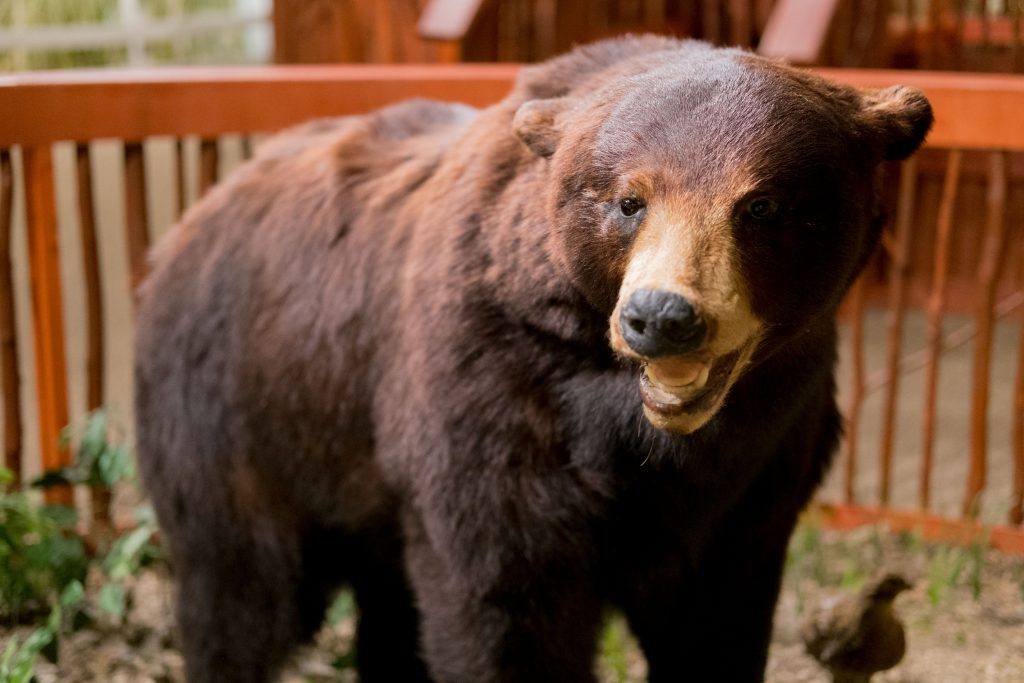
Animals around every corner, squawking bird noises, varying climates — no, it’s not a zoo.
On Feb. 16, the Roberson Museum and Science Center on the West Side of the city of Binghamton opened NatureTrek, an immersive exhibition that invites viewers to take a closer look at the wildlife that surrounds them in upstate New York.
NatureTrek features models of five different ecological areas: deciduous and transitional forests, wetlands, meadows and backyards. Each life-size diorama displays artificial replicas of local plant life and various taxidermic animals commonly found in the environment, including birds, bears and deer.
These mounted animal specimens were donated to the Roberson Museum by Lee J. Loomis, an accomplished taxidermist and lifelong resident of Broome County who died in 1979. The Roberson Museum has roughly 3,000 specimens in its Lee J. Loomis collection, but only a fraction of these are displayed in NatureTrek.
The habitats showcased in NatureTrek are carefully crafted with accurate ecological details. During a walkthrough of the exhibition, Peter Klosky, ‘73, director of exhibitions for the Roberson Museum, pointed out a small red bird called a scarlet tanager in the forest habitat.
“This [habitat] is supposed to be [set in the] fall,” Klosky said. “Scarlet tanagers, going into October, start losing their red color. So, it was important for us that, if we had to include that bird in here, to set this in late September.”
The installation of NatureTrek was a three-year process and a collaborative effort every step of the way. The idea for the project was first introduced by Terry McDonald, the Roberson Museum’s former executive director. When McDonald stepped down in 2017, the position was taken over by Michael Grasso, ‘07, an Endicott native who continued the project.
The bird noises echoing throughout the exhibition were provided by the Cornell University Lab of Ornithology. Numerous local organizations, including Binghamton University’s Nuthatch Hollow Nature Preserve, were consulted when constructing the different ecological areas.
“This has really been worthwhile,” Klosky said. “We’ve had a lot of great partnerships, great volunteers, a lot of input from the community.”
NatureTrek also features a number of interactive elements, including touch-screen digital displays of animal noises, which were also provided by the Lab of Ornithology. With the touch of a finger, visitors can hear any animal noise of their choosing, an experimental feature that has only been a part of 24 other installations worldwide.
Interactive features also run throughout each individual diorama. Mobile information displays are stationed next to every area, inviting viewers to turn each panel to reveal more information about current threats to the habitat and what they can do to help preserve it.
NatureTrek encourages viewers to continue their exploration long after they’ve left the Roberson Museum. A large plaque titled “Nature Areas For You To Discover” marks the end of the exhibition, citing 33 nature preserves, forests and state parks to explore all over the greater Binghamton area. The Binghamton University Nature Preserve is listed as the second suggestion in the section about Broome County.
“One of the big themes is to get people not just to watch nature on public television where you see the Serengeti, but to start appreciating wildlife in your own backyard,” Klosky said.
Klosky, who has been working at the Roberson Museum for 40 years, said that he loves the museum because it allows him to explore his varied interests, including art and natural history.
“I’ve been able to spend my life being surrounded by things that I really enjoy,” Klosky said. “Not too many people, I think, get to do that.”
Grasso only recently joined the team in November 2017, but his words echoed Klosky’s.
“[The Roberson Museum] was the first museum that I had ever been to,” Grasso said. “This was my hometown museum and it was always my dream job to be at [the Roberson Museum].”
As a BU alumnus, Grasso also had some words of advice for current BU students who might be on the fence about visiting NatureTrek.
“All big colleges are bubbles,” Grasso said. “Whenever you can get outside of the bubble to experience something new, learn a little bit more about the world around you from outside of the classroom, I think that’s a good opportunity and you should take it.”
NatureTrek will stay on as part of the permanent collection at the Roberson Museum.


